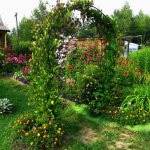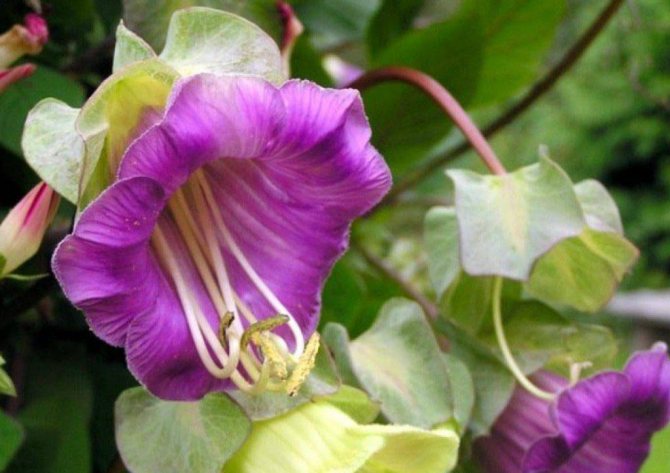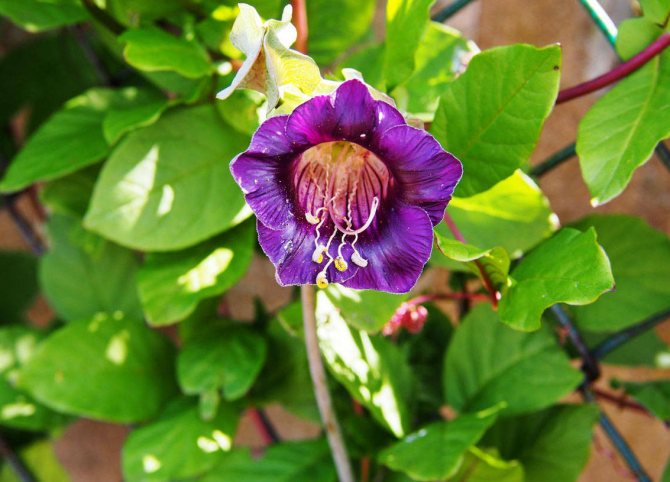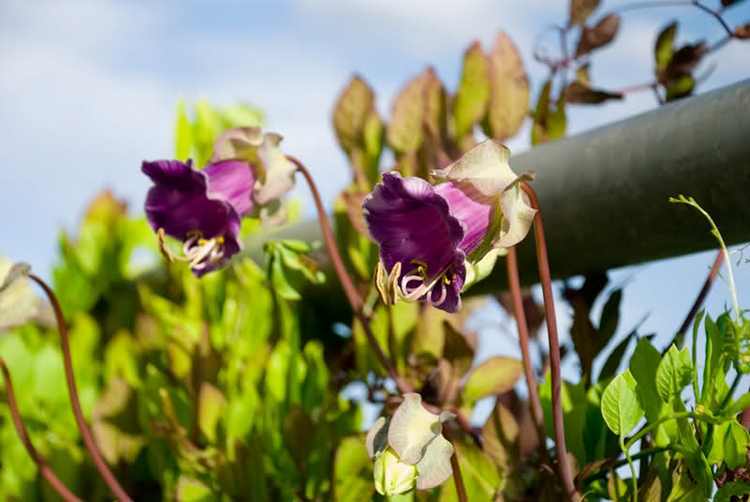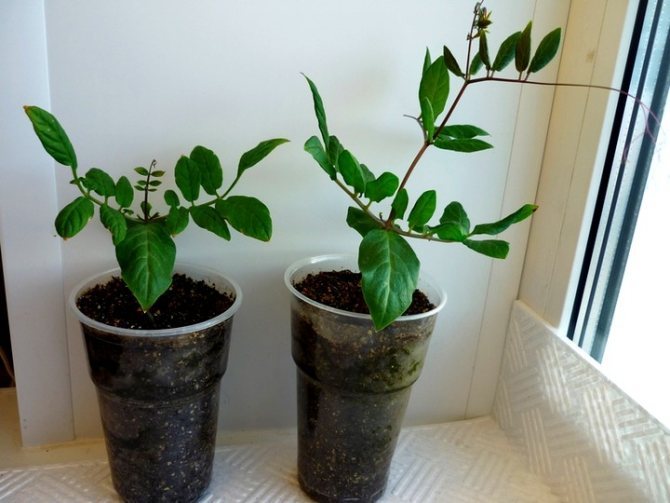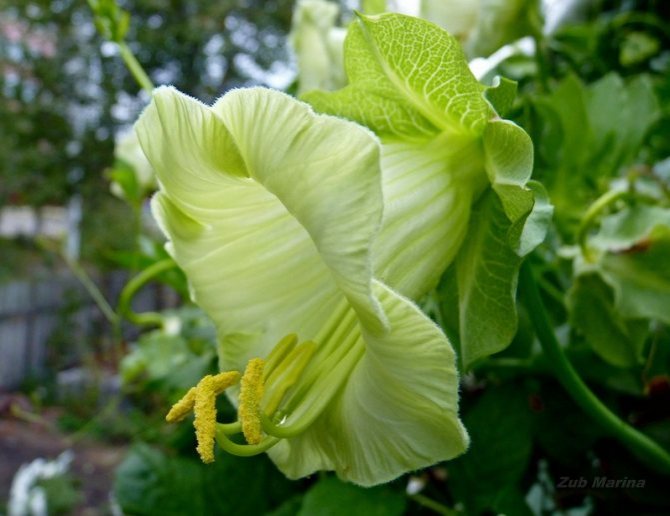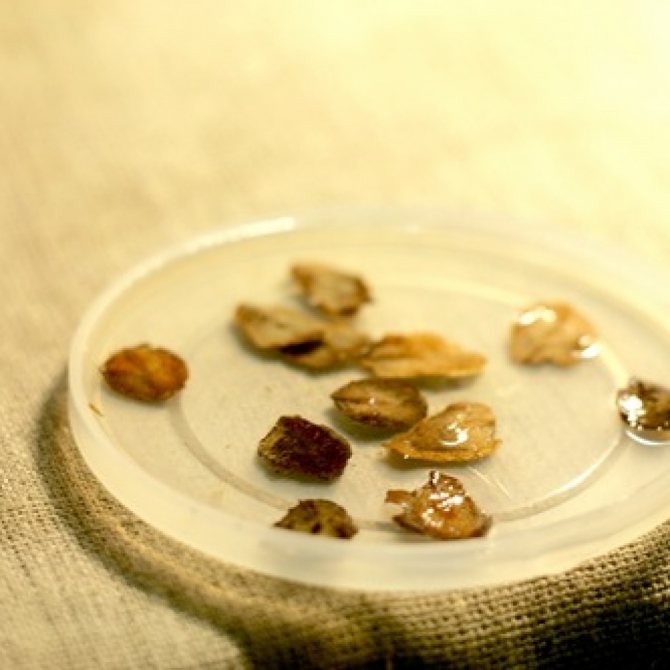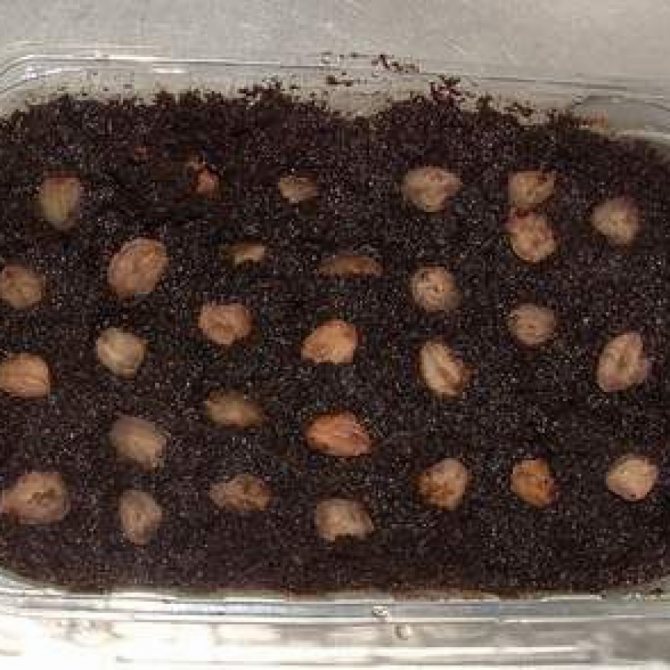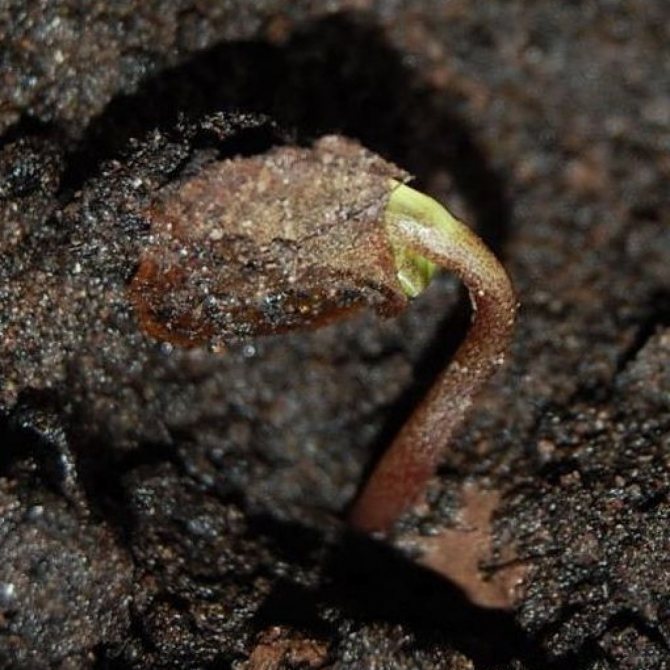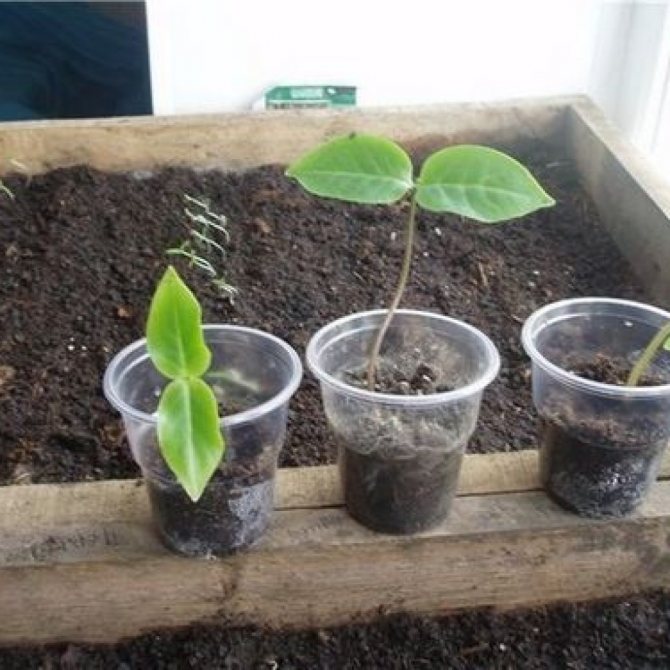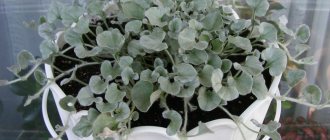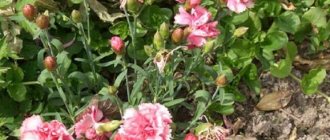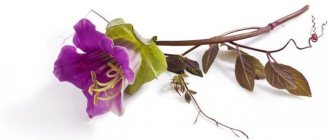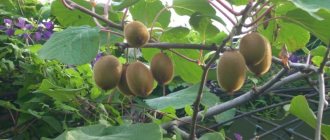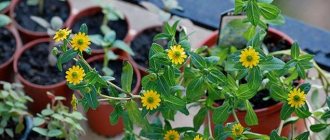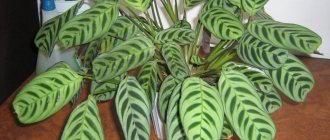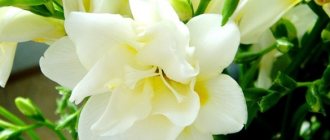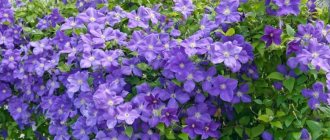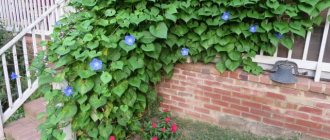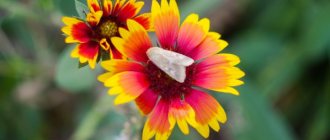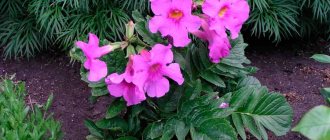Kobei and her features
Often popular in Russia are of overseas origin. Therefore, many plants are either not able to get used to our climate at all, or they adapt over the years (as a result of which its characteristics and agricultural technology change).
Sadovaya kobeya was no exception to the rule. It is used for vertical gardening, has the appearance of a liana, is warm and light-requiring. With proper care, it will reward you with luxurious thickets.
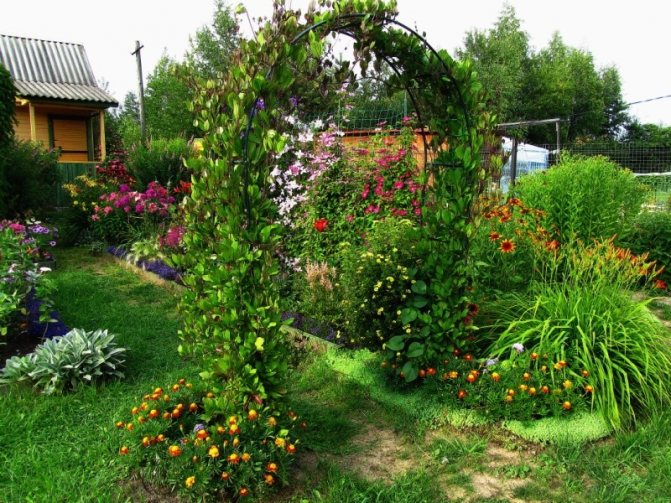
Kobea climbing in the landscape
Origin
In this case, the plant came to the Eurasian continent from South America. Especially common in Peru and Mexico. There, in a hot and humid tropical climate, kobei can be described as follows:
- it is a perennial flower;
- in natural conditions, it reproduces by self-sowing through falling seeds;
- has more than 10 types;
- adult plants reach a height of 5-8 m;
- the diameter of the flower bell is up to 10-11 cm;
- clings tightly to the support with antennae.


There are more than 10 species of kobei in the world
In Russian conditions
We have a kobei in Russia:
- not able to develop by self-seeding;
- is an annual plant;
- propagated by seeds;
- grows up to 3-5 m high;
- has a flower bell diameter up to 6-8 cm.
IMPORTANT. The planting material has to be bought again every year, because in the climatic conditions of our continent, the seeds do not have time to ripen.
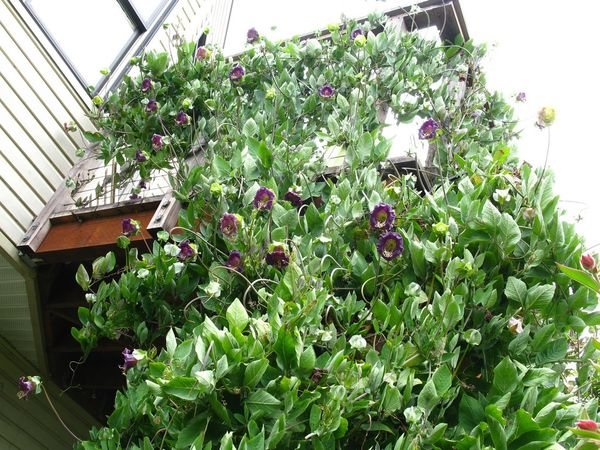

Kobeya grows up to 3-5 m in height
What is attractive
Kobei is appreciated for being:
- creates the illusion of a jungle;
- allows you to hide unsightly elements under the thickets - old cracked walls, unsightly design defects, etc.;
- gives aesthetic pleasure from the process of growing and caring for the plant;
- feathery leaves;
- profuse flowering;
- pleases the eye with purple and greenish-white bell-shaped flowers;
- foliage is quite dense, with horizontal-vertical branching (it is possible to create the illusion of a green carpet);
- growing rapidly;
- flowering lasts until the first frost.
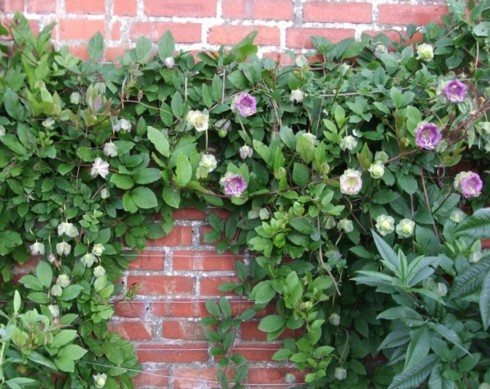

Kobea allows you to hide unsightly elements under the thickets
Soil requirements
Due to the fact that the kobea was "born" in the southern latitudes, it requires soils with the following characteristics:
- stable moderately moist;
- soft;
- loose.
Natural tropical soils are just like that. Russian gardeners have to focus on:
- systematic loosening;
- tracking humidity and moisture;
- soil nutrition.
IMPORTANT. Use quality fertilizers from specialty stores. There, the product is targeted in a targeted manner - consult a competent salesperson.
general description
Using kobei, people decorate arches, hedges, gazebos and balconies in their gardens. In the harsher climatic conditions of Russia, this ornamental plant is grown as an annual. In nature, there are 9 species of lianas in total, which belong to the genus Kobei. At the same time, gardeners use only one species - climbing kobe. This vine also has other names:
- Mexican ivy.
- Creeping Kobe.
- Monastery bells.
Kobeya is a curly shrub, which has a branched and powerful root system, presented in the form of thin fibrous roots. In one season, this plant can grow more than 6 m in length.
The kobei has a branched stem, covered with beautiful complex-pinnate leaves, which are arranged alternately. The stem is angular. At the ends of each shoot are antennae, which are modified leaves. With the help of these antennae, the vine can rise to a great height on almost any surface.
The plant is fed by a powerful root, so the kobea develops very quickly. In a short period of time, the plant is able to braid a vertical surface of a large area, which is very important in landscape design when gardens or personal plots are made out.
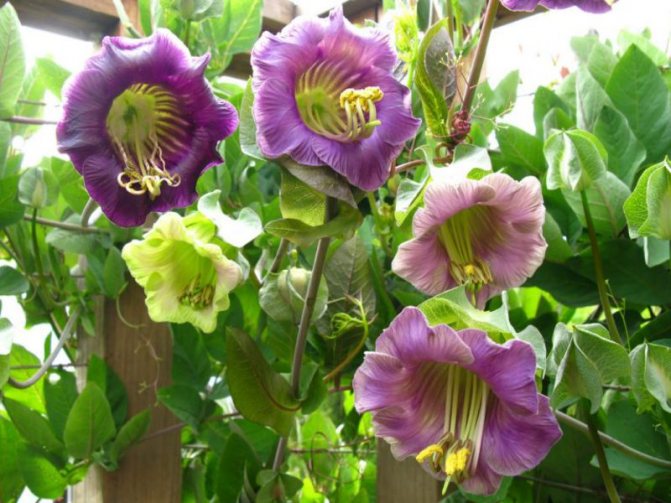

Peduncles are located in the leaf axils. In length, the peduncles reach 20 cm. The flowers of the kobei are fragrant, rather large. They are bell-shaped. The flower reaches 8 cm in diameter. Because of the petals, the stamens and pistils protrude strongly. Thanks to this, the flowers look unique and graceful. They are located in pairs or singly.
The flowering of the kobei is very long. Liana can bloom even before the first frost. The plant blooms with the arrival of July. At the end of the season, fruits are formed from the flowers. Outwardly, the fruits resemble a box. The seeds are rather large, oval, flat. When the buds bloom, the flowers smell of musk, a greenish-creamy shade. However, over time, the flower changes, and the smell takes on a different scent. The color of the petals turns purple or white. The shade will depend on the variety. The aroma of musk changes to honey.
Seedling
It will not be difficult for experienced gardeners to breed a home jungle from kobei. Beginners will have to spend a little more time studying agricultural technology, but it is also possible to achieve a positive result at low cost.
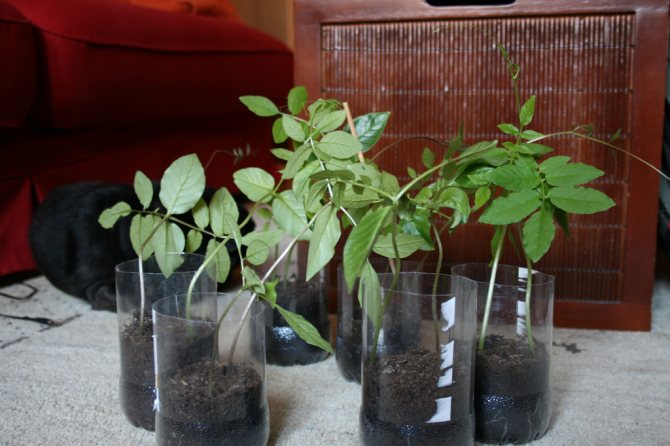

Kobei seedlings
Seed preparation
As soon as you buy seeds in the store, immediately consider: first you need to turn them into seedlings (planting seeds in open ground means dooming them to death). But for seedlings, seeds require some preparation:
- it is necessary that each seed is nailed before planting in the seedling containers;
- spread the seeds on a damp cloth (toilet paper or paper napkin folded in several layers is also suitable);
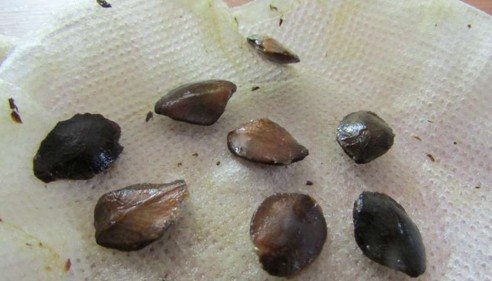

Seed soaking
IMPORTANT. Make sure that each seed is at a distance from others and does not touch neighboring ones.
- Moisten a cloth with seeds, cover with plastic wrap;
- place where it is not cold and there is good access to light;
- after 10-14 days, the seeds should hatch;
- if you see mold in places, gently wash the seeds and cloth (or change the paper);
- those seeds that have successfully hatched, it's time to plant them in the ground for growing seedlings.
Seed embedding
Now the prepared seeds need to be turned into seedlings that can adapt in the open field:
- for growing seedlings, sowing should be started in late February - early March;
- use boxes no more than 15-18 cm high;
IMPORTANT. Soak the seeds without preliminary preparation for several hours in a solution of a growth stimulant (check this in specialized stores - what substance and how to breed).
- seeds require planting to a depth of 1.5 cm;
- lay them flat side down in the ground;
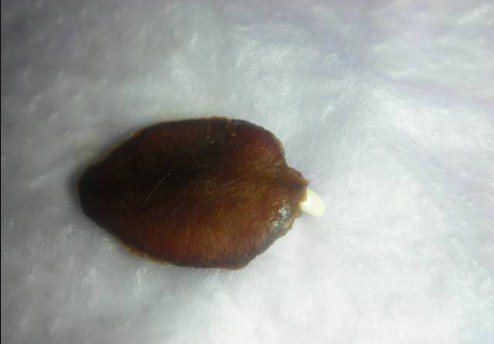

Sprouted Kobei seeds
- the temperature of the room where the box with seedlings is located should be 19-20 degrees;
- fill boxes 5-7 cm with soil from a specialized store (intended for flowers or for mixing with garden soil);
IMPORTANT. If everything is done correctly, seedlings will appear in 14-20 days. Please note that the germination rate of seeds is about 30% - it's not about the reliability of the supplier, but about the specifics of the plant itself.
Growing seedlings
Once the seeds are planted in the ground, note the planting date on your notebook. This will help you keep track of the dynamics.Use the experience gained for the next year, because you will like the kobei so much that you will probably want to leave it in your garden forever.
Regular actions:
- until the seeds have sprouted, check the soil in the box - it should be moderately moist (but in no case swampy-viscous);
- slight drying on the surface is permissible (however, it is impossible for the soil to dry out inside);
- seeds in the ground do not require light - the main thing is heat and moisture.
Cupping
An important stage is the cropping of plants. When transplanted into separate containers, further strengthening and development is ensured. It depends on this stage how well the kobea will subsequently endure placement in the open field.
What do we have to do:
- with the appearance of the first shoots, track the moment when the first leaf appears, or even better - two;


The first shoots of kobei
- when the first leaves have appeared, stop plants 1 pc. in separate pots;
- of great importance is such a factor as the size of the containers. Boxes or pots must be voluminous - otherwise the root system will not be able to fully develop;
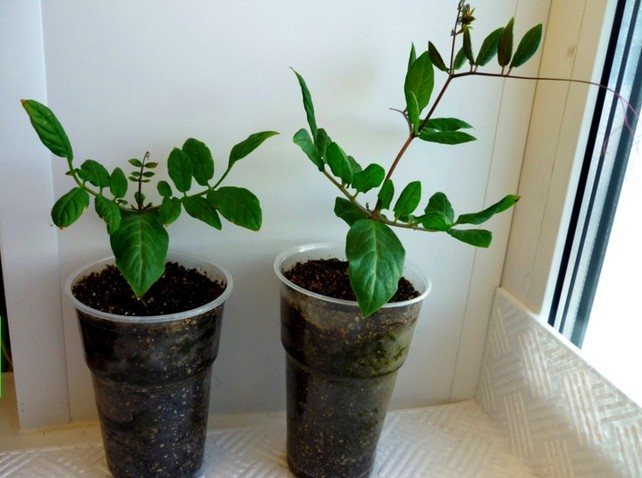

For growing kobei, the pots must be voluminous.
IMPORTANT. The seedlings are to be planted in the ground together with the root ball. Make sure there is enough soil in your seedling pots or boxes.
- focus on a capacity of 3-4 liters;
- for support, put an independent peg in each pot in advance. Already a few days after docking, the kobei will begin to look for something to catch on - such is its curly nature;
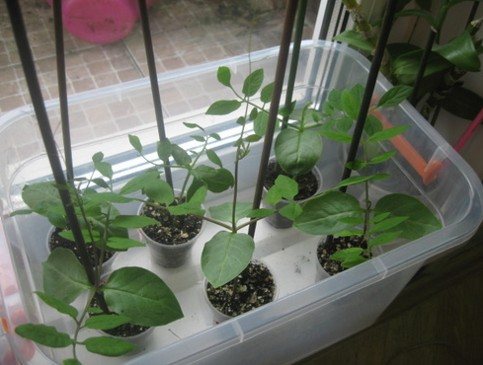

For support, put an independent peg in each pot in advance.
- from this moment it is no longer so critical to observe high temperatures - the plant feels good even at 14-15 degrees of heat. The main thing is to beware of frost so that the kobei does not get frost on the loggia or glassed-in balcony;
IMPORTANT. On warm sunny days, it is useful to take the seedlings outside so that it begins to get used to its natural environment.
Video - Seeding and diving kobei
Transfer to the ground
Fundamental rules:
- seedlings are planted in open ground in late May - early June;
- it happens that the year is especially hot, all processes are accelerating - then a transplant is possible in mid-May (the same applies to the warmest regions of the country);
- start planting only after the danger of frost has completely passed.
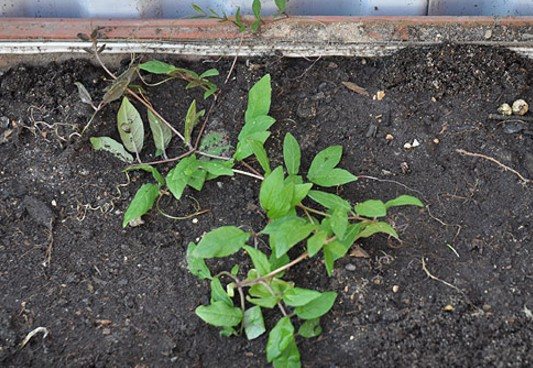

Transplanting kobei into the ground
Distance
Vineyards require optimal spacing between adjacent plants. It is necessary that there is no tightness, and also so that the growing antennae can reach each other.
IMPORTANT. At a smaller distance, it will be too close, and at a larger distance, it will be much more difficult for the plant to cling to each other with its antennae, and the effect of the "green carpet" will largely weaken.
Soil and light
The climbing kobei claims to be prepared ground and the absence of a shadow:
- strictly follow the lighting requirements - kobei grows well in richly lit places. Moderate shading is acceptable but not desirable. Complete blackout is strongly discouraged (the plant will wither);
- remember that the soil must be fertile. To make it easier for yourself, set up fenced planting rows or containers with fertile soil under the annual planting. Then you will only have to dig it up from year to year in the spring.
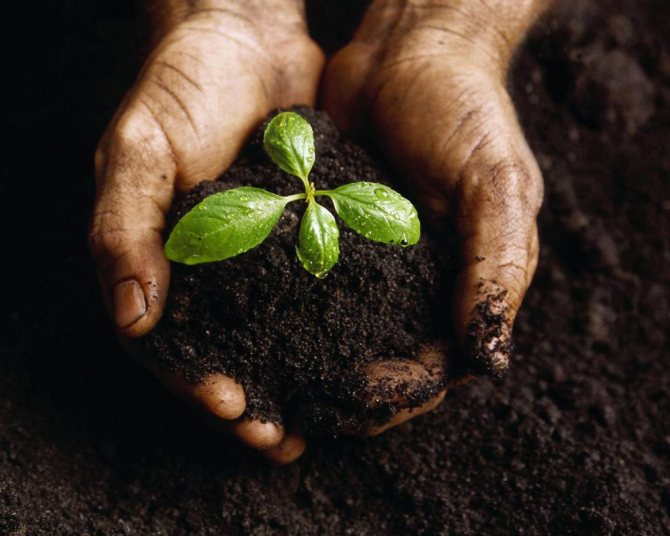

The soil for the kobei must be fertile.
Planting plants in the ground
- mark the holes (the distance between the plants should be from 60 to 80 cm);
- dig the earth to a depth based on how much the root system has grown (make a vertical and horizontal margin of 5-7 cm, because the roots will still continue to grow in open ground);
- spill the holes with water, wait until the water is absorbed into the ground;
- do not forget that there must be fertile, loose soil in the holes;
IMPORTANT.To make the plant "slip out" easily along with the root ball, water it beforehand while it is in the seed pot.
- place each plant in a separate hole;
- sprinkle gently with soil on top;
- pour water (only not ice, but previously settled at room temperature).
How to grow a kobei from seeds on the balcony
A flower is also grown on the balcony, it looks very impressive and protects from the sun. You can grow a vine at home in the same way as in an open garden. Before planting, you need to rid the seed material from the shells for better germination. Then prepare the soil for planting. Peat or coconut substrates are ideal.
It is better to take a large container for planting, because the flower has a developed root system. And due to the fact that the transplant is poorly tolerated, sprouted seeds, it is better to plant them in a permanent place of residence, in a flowerpot or box.
As the lashes stretch out, they need to change the support so that the stems do not intertwine with each other. A tropical inhabitant requires abundant watering, constant feeding. The soil needs fertile, loose. This will be the key to abundant flowering. Kobeya will braid the balcony, protect from the sun's rays.
Care
Once the plants are in the ground, they require further care. And he, in turn, consists of four stages:
- watering;
- weeding;
- fertilizer;
- protection against pests.
Watering
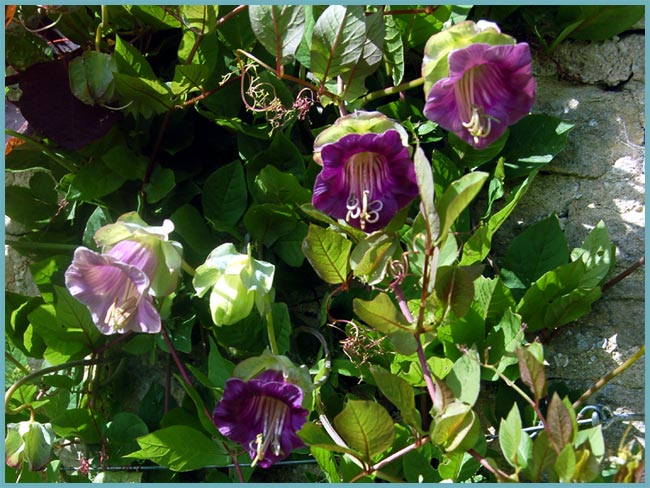

Kobea requires frequent watering
The kobei has an amazing genetic memory. The plant still requires the same conditions in which its distant South American tropical ancestors grew. Even now, the situation in the tropics has not changed, and the Eurasian "relative" still requires sufficient humidity.
Therefore:
- water the kobei as often as possible;
- pour not into the holes, but over the entire plantation from a hose or watering can (in this way you will not only provide the root system with water, but also every cell of the plant - it will be easier for it to breathe).
IMPORTANT. Pouring roots is a dangerous extreme. The soil should be moist, but not marshy. Otherwise, there is a risk of root rot formation.
Fertilizer
Throughout the growth and development of the kobei needs elements such as:
- phosphorus;
- potassium;
- nitrogen.
However, there are subtleties of feeding:
- nitrogen is extremely necessary in the "infancy" age;
- when forming buds, phosphorus and potassium are needed;
IMPORTANT. Prolonged nitrogen abuse will lead to the fact that foliage will dominate in an adult plant, and there will be very few flowers.
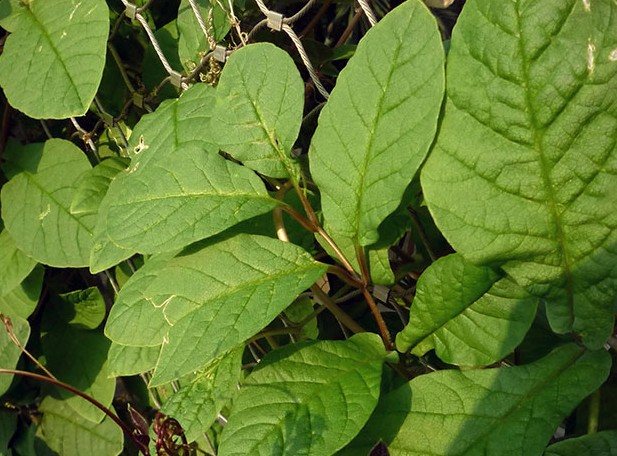

Throughout the growth and development of the kobe, it needs feeding.
- buy special mineral mixtures in flower and garden stores (by all means specifying what exactly and what composition);
- start feeding the plant literally from the first days of life;
- fertilization frequency - weekly. This will make the kobei grow steadily and evenly.
Pest control
What dangers lie in wait for a climbing cobe during the formation of buds, during flowering and further growth:
- pests - spider mites and aphids;
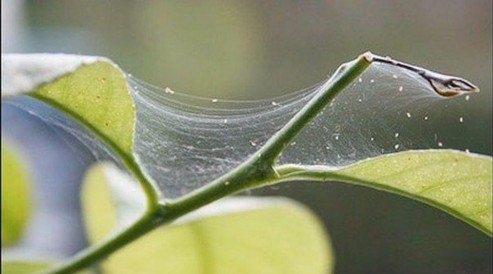

Spider mite
- if the attacks of parasites are not prevented in time, the leaves will shrivel and take on a dull, painful appearance.
Methods of struggle and correction:
- immediately remove and burn infected leaves;
- treat the plant with a "bump" of laundry soap on water;
- for prevention, use special solutions (you can buy them in gardening stores).
Popular varieties
Why Potentilla does not bloom - how to feed
Of the 9 species of Cobaea known to science, only one is grown in Russia - a climbing or creeping variety of a plant.
Kobeya creeping is distinguished by its unusual leaves and large bell-shaped flowers that exude a tart musky smell. Kobei grows very quickly, which is good for a short summer in central Russia.
Designers make extensive use of the flower when decorating landscapes. The most popular kobei varieties:
- Alba. It has large white flowers that hang down beautifully.
- The Tsar Bell. Delicate white flowers delight the eye from mid-summer to the very frost.
- Cathedral bells. The flowers are large, purple in color. Flowering continues until the first frost.
- Colando. This variety has large blue-purple flowers with a long pistil protruding from the petals. The plant is thermophilic, so you need to plant it in the sun.
- Amazon. It has a lush liana, reaching a length of 4 m. The flowers of this kobei are purple, pleasing to the eye for several months.
Annual or perennial
In Russian conditions, it is very difficult to grow a kobei as a perennial. Only the most desperate fanatic gardeners succeed in this. It is much easier to buy new seeds every year. But if you still want to go further, use a simple recipe for preserving an existing plant for next summer:
- in mid-October, carefully cut the stalks of the kobei with a sharp garden knife;
- dig up the liana with the roots;
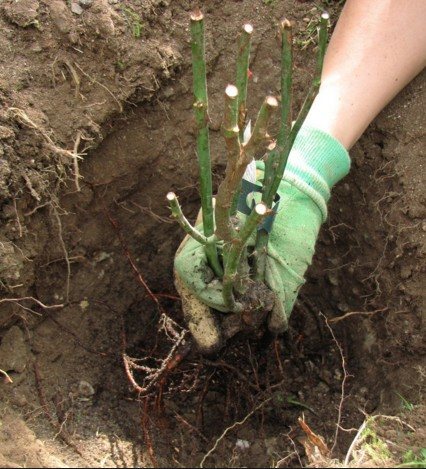

Digging up kobei for the winter
- place in a spacious container along with the soil on the roots;
- place the container in the cellar (without frosty air, but so that there is moderate humidity);
- in this way, the climbing kobe will be able to winter safely;
- around mid-March, remove the container and start watering the plant indoors;
- when warm days begin, plant it back into the soil.
Remember that growing flowers requires attention and responsibility. As for the climbing kobei, we can say that it is a rewarding job - to prepare seedlings, plant them in the ground and take care of the plant. In return, you get an original landscape design, a wonderful way to decorate architectural elements and satisfaction from the work done.

